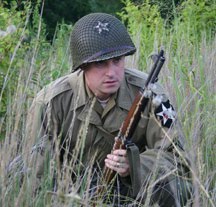 |
| A Marine of the 1st Division stands determined on the muddy hills of Okinawa. |
My April Uniform of the Month is a tribute to the brave Marines and U.S. Army soldiers who fought in the last great battle of World War II on the Japanese island of Okinawa. Will and Casey and I headed out on a rainy morning to try to capture the essence of what being wet is all about. The temperatures were around 50° with a steady rainfall that got quite heavy at times. Casey and I were representing the Marines of the 1st Marine Division and Will was representing the Army's 77th Infantry Division.
The Battle of Okinawa, codenamed Operation Iceberg, was fought on the Ryukyu Islands of Okinawa and was the largest amphibious assault in the Pacific War. The 82-day-long battle lasted from early April until mid-June 1945. After a long campaign of island hopping, the Allies were approaching Japan, and planned to use Okinawa, a large island only 340 mi (550 km) away from mainland Japan, as a base for air operations on the planned invasion of Japanese mainland (coded Operation Downfall). Four divisions of the U.S. 10th Army, the 7th, 27th, 77th, and 96th Infantry Divisions and two Marine Divisions, the 1st and 6th, fought on the island. Their invasion was supported by naval, amphibious, and tactical air forces.
The battle has been referred to as the "typhoon of steel" in English, and tetsu no ame ("rain of steel") or tetsu no bōfū ("violent wind of steel") in Japanese. The nicknames refer to the ferocity of the fighting, the intensity of kamikaze attacks from the Japanese defenders, and to the sheer numbers of Allied ships and armored vehicles that assaulted the island. The battle resulted in the highest number of casualties in the Pacific Theater during World War II. Based on Okinawan government sources, mainland Japan lost 77,166 soldiers, who were either killed or committed suicide, and the Allies suffered 14,009 deaths (with an estimated total of more than 65,000 casualties of all kinds). Simultaneously, 42,000 to 150,000 local civilians were killed or committed suicide, a significant proportion of the local population. The atomic bombings of Hiroshima and Nagasaki together with the Soviet invasion of Manchuria caused Japan to surrender less than two months after the end of the fighting on Okinawa.
 |
| The location of our photo shoot had some excellent broken concrete slabs which really added to the realism of the environment. |
 |
| Here I am keeping a vigilant watch over the ridge line with my trusty M-1 Rifle. I am wearing the Marine Corps' camouflage poncho. |
 |
| This was Casey's first event as a Marine and I think he had a good time. He's wearing the standard Marine P41 Utilities. |
 |
| Marines would sometimes wear the Army's M-1941 Field Jacket in colder weather as seen here. However, Field Jackets are not waterproof. |
 |
| Casey and I are holding a captured Japanese "meatball" flag as a souvenir. Note how well the camouflage poncho blends in with the background. |
 |
| This was our extremely shallow scrape that we sat and ate some C-Rations in. Note the T-Handle Shovel to Casey's right. |
 |
| When dealing with rain and mud, the Marine Corps leggings are extremely valuable in keeping the muck out of your Boondockers. |
 |
| The Marine Corps poncho can be used as a shelter as well if you unsnap the sides. It has reversible green and brown sides. |
 |
| The Marines typically wore their helmet chinstraps fastened or left them hanging loose. |
 |
| Here Casey and Will make their way down a stream. Will's helmet has the horizontal white stripe of a non-commisoned officer. |
 |
| Will is wearing the Army's poncho which unlike the Marine version is not camouflaged. He is also carrying an M-1 Rifle. |
 |
| Mud and misery were the name of the game on Okinawa. It's hard to imagine that some of these guys lived through three solid months of this. |
 |
| Time for a smoke and a warm meal. |

















